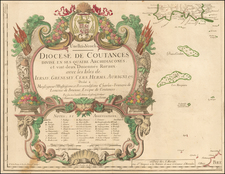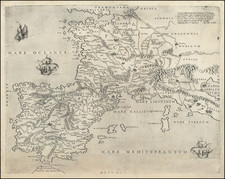15th-century woodblock showing a collection of idealized views of cities in the Holy Roman Empire by Hartmann Schedel, from his 1493 Nuremberg Chronicle.
Divided into three groups, the cities pictured are: Augsburg (Augusta), Metz (Metis), Aachen (Aquilgranu), and Lubeck as "The Four Cities"; Bamberg, Selestat (Sletzstat), Haguenau (Haganau), and Ulm (Ulma) as "The Four Villages"; and Cologne (Colne), Regensburg (Regenspurg), Konstanz (Costens), and Salzburg as "The Four Country Estates". The Four Cities are shown with high stone walls; The Four Villages and The Four Country Estates are shown with the half-timbered architecture characteristic of the area.
On verso: at left are portraits of papal succession, showing John XVIII, Sergius IV, Benedict VIII, John XIX, and Benedict IX, and at right portraits of the secular princes: the King of Bohemia, the Count Palatine, Duke of Saxony, and Margrave of Brandenburg; representations of the four landgraves of Thuringia, Hesse, Leuchtenberg, and Alsace; the burgrave of Stromberg; and the four counts of Schwartzburg, Cleve, Cilli, and Savoy.
Hartmann Schedel (1440-1514) was a physician, book collector, and writer whose most famous work, the Liber Chronicarum (Nuremberg Chronicle), included some of the first printed views of many cities in Europe and across the world.
Schedel was born and died in Nuremberg, but he also traveled for his education. From 1456 to 1463 he lived in Leipzig, where he attended the University of Leipzig and earned his MA. From there he went to Padua, where he earned a Doctor of Medicine in 1466. After university, he worked for a time in Nördlingen and then returned to Nuremberg. In 1482 he was elected a member of the Great Council of Nuremberg.
The Chronicle was published in 1493. Besides this major work, one of Schedel’s most enduring legacies is his magnificent manuscript and printed book collection, one of the largest of the fifteenth century. In 1552, Schedel's grandson, Melchior Schedel, sold about 370 manuscripts and 600 printed works from Hartmann Schedel's library to Johann Jakob Fugger. Fugger later sold his library to Duke Albert V of Bavaria in 1571. This library is now mostly preserved in the Bayerische Staasbibliothek in Munich.
Among the surviving portions of Schedel's library are the records for the publication of the Chronicle, including Schedel's contract with Anton Koberger for the publication of the work and the financing of the work by Sebald Schreyer and Sebastian Kammermeister, as well as the contracts with Wohlgemut and Pleydenwurff for the original artworks and engravings. The collection also includes original manuscript copies of the work in Latin and German.











![(Second World War - Occupation of Germany) Карта Группировки Союзных Оккупационных Войск в Германии по УКА ГСОВ в Германии [Map of the Grouping of the Allied Occupation Forces in Germany according to the UKA GSOV in Germany] | Административное Деление Германии на 1 июня 1939 Года [Administrative Division of Germany on June 1, 1939]](https://storage.googleapis.com/raremaps/img/small/72174.jpg)
![(First World War - German Propaganda) Die Eisenbahn, der Lebensnerv des Heeres. [The railway, the lifeblood of the army.]](https://storage.googleapis.com/raremaps/img/small/89362.jpg)
![[ Holy Roman Empire ] A New Map of the German Empire, and the Neighbouring States with their Principal Post Roads, Originally Published by the Royal Academy of Berlin . . . 1788](https://storage.googleapis.com/raremaps/img/small/102913.jpg)
![Le Costa della Francia sul mare Oceano [The Coast of France on the Oceanic Sea]](https://storage.googleapis.com/raremaps/img/small/90844.jpg)